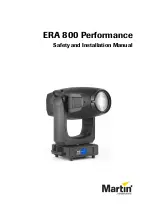
PRESSURE FLOW
VACUUM FLOW
Figure 6.
Pressure and Vacuum Flow
PPE Warning
▲
WARNING
Wear protective gloves and clothing to prevent
skin contact when handling lead weights. Wear
eye protection. Avoid breathing dust/fumes/
mist/vapors/spray. Do not eat, drink or smoke
while using the product. Avoid release to the
environment. Wash hands with soap and water
after handling. Keep away from excessive heat
and open flames.
▲
WARNING
Make sure line is free of hazardous vapors
before installing or servicing the valve.
Principle of Operation
Refer to Figure 6. The Enardo 2000 and Enardo 2500 Series
maintain a tight seal until system pressure or vacuum
exceeds the set pressure of the vent. To adjust the set
pressure, a series of weights may be stacked onto the lid
assembly. When overpressure occurs, the weighted lid
assembly lifts, breaking the seal between the seat and
seal portion of the lid assembly. This allows vapors to pass
through the vent orifice and relieve pressure build up. The
vent reseals upon relief and remains sealed.
Remote Monitoring Option
The Smart Wireless option for the Enardo 2000 Series
consists of the EPRV, a proximity sensor, and a wireless
transmitter. The built-in proximity sensor detects the open
or closed position using a magnetic target located on the
arm assembly on the hinged end. A signal is sent to the
wireless transmitter, which can then be sent to a control
room via any WirelessHART
®
Gateway. This wireless sensor
networking technology is based on the Highly Addressable
Remote Transducer (HART
®
) protocol. It is the most widely
used wireless networking standard used today and, for
this reason, the Enardo 2000 Series has been designed
to integrate with it. As long as the wireless gateway is
WirelessHART
®
, it will receive the Open or Closed signal
from the device. The WirelessHART
®
gateway will then send
the information to a control room which can make use of any
number of software integration packages.
HART
®
and WirelessHART
®
are marks owned by FieldComm Group.
It is important to note that relieving vapors near the set
pressure in a continuous manner may cause the lid
assembly to flutter or oscillate. This is a common occurrence
in products of this type in the industry. Operating the vent
with flutter or oscillation over time may cause premature
vent damage or wear. Contact your local Sales Office for
additional assistance.
4
Enardo 2000 and Enardo 2500 Series
Outside North
America Only


























